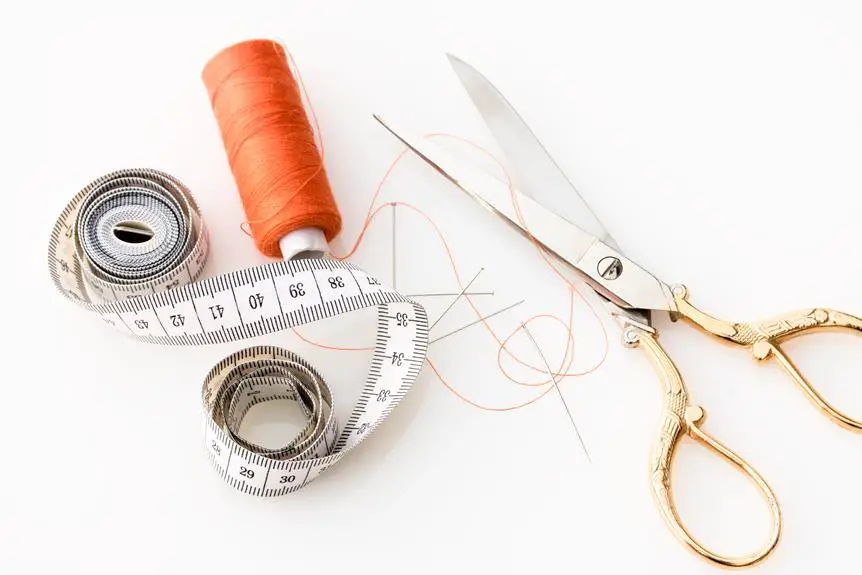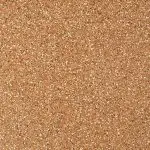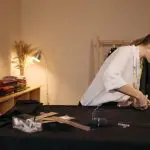So, you're on the quest for the ultimate cloth cutting shears, huh? Well, look no further because we've got you covered.
When it comes to mastering the art of fabric cutting, the right shears can make all the difference. From understanding the different types of shears to maintaining and sharpening them, we've got the inside scoop on everything you need to know.
Get ready to discover the top 5 cloth cutting shears for precision cuts, learn about ergonomic design and comfort for extended use, and find budget-friendly options that won't break the bank.
It's time to take your fabric cutting game to the next level with the best cloth cutting shears for fabrics.
Key Takeaways
- Understanding the different types of shears, such as fabric shears, pinking shears, and rotary cutters, is essential for choosing the right tool for the job.
- Key features to look for in cloth cutting shears include an ergonomic grip, high-quality blade material, sharpness and thickness of the blades, and comfortable handles.
- The top 5 cloth cutting shears for precision cuts are Fiskars Classic 8 Inch Sewing Scissors, Gingher 8-Inch Knife Edge Dressmaker's Shears, Kai 9.5 Inch Professional Shears, and proper maintenance and sharpening techniques are necessary for their longevity.
- Ergonomic design and comfort are important for extended use of fabric shears, especially for professionals like tailors, seamstresses, and quilters. Investing in shears with an ergonomic design improves efficiency and productivity.
Understanding the Different Types of Shears
You should differentiate between the various types of shears to understand their specific uses for fabric cutting.
There are several types of shears designed for cutting fabrics. Fabric shears, also known as dressmaker shears, are great for cutting long, straight lines. They've a bent handle to keep the bottom layer of fabric flat on the cutting surface.
Pinking shears are another type, with sawtooth blades that create a zigzag edge on fabric to prevent fraying. These are ideal for finishing seams and decorative edging.
Additionally, there are rotary cutters, which are perfect for cutting through multiple layers of fabric with precision. Each type of shear offers unique benefits for different fabric cutting needs.
When it comes to materials, most shears are made of stainless steel, providing durability and resistance to rust. It's essential to keep your shears clean and dry to prevent rust and damage. Regularly oiling the joint of the shears and wiping them with a soft cloth after use can help maintain their sharpness.
Proper care ensures that your shears will last longer and continue to provide clean, precise cuts for your fabric projects.
Key Features to Look for in Cloth Cutting Shears
When selecting cloth cutting shears, look for features that enhance precision and comfort during use. An ergonomic grip is crucial for reducing hand fatigue and providing better control while cutting through fabrics. Look for shears with handles that fit comfortably in your hand, allowing for extended use without discomfort.
Additionally, consider the suitability of the blade material for cutting fabrics. High-quality stainless steel or titanium blades are durable and maintain sharpness, ensuring clean and precise cuts. These materials also resist corrosion, making them suitable for long-term use in fabric cutting.
When examining the shears, pay attention to the sharpness and thickness of the blades, as these factors significantly impact their cutting performance. A finer edge and thinner blade are generally better for cutting through delicate fabrics with accuracy.
Top 5 Cloth Cutting Shears for Precision Cuts
For achieving precision cuts in fabric, consider the Fiskars Classic 8 Inch Sewing Scissors with comfort grip handles. These shears are designed to provide exceptional precision when cutting various fabric types. The stainless steel blades are durable and sharp, allowing you to achieve clean and accurate cuts every time. The comfort grip handles reduce hand fatigue, making it easier to maintain control and accuracy during extended cutting sessions.
Another top pick for precision cutting is the Gingher 8-Inch Knife Edge Dressmaker's Shears. These shears are renowned for their precision and sharpness, making them ideal for intricate cutting tasks. With proper shears maintenance and sharpening techniques, these high-quality shears can last for years while consistently delivering precise cuts.
When it comes to precision cutting on delicate fabrics, the Kai 9.5 Inch Professional Shears are highly recommended. These shears feature a longer blade, allowing for smooth and precise cutting on various fabric types, including silk and satin. Proper maintenance and sharpening techniques will ensure that these shears remain reliable for precision cutting tasks.
Maintaining and Sharpening Your Fabric Shears
To maintain optimal cutting performance, regularly sharpen your fabric shears using a quality sharpening stone or professional sharpening service. Proper maintenance is crucial to ensure that your fabric shears remain effective and precise. When it comes to sharpening techniques, it's important to use the right tools and methods to maintain the integrity of the blades. A high-quality sharpening stone is a great investment for keeping your fabric shears in top condition. It's essential to follow the manufacturer's guidelines for the specific sharpening tools suitable for your shears.
The frequency of sharpening largely depends on how often you use your fabric shears. If you use them frequently for heavy-duty cutting, you might need to sharpen them more often. However, as a general rule of thumb, it's advisable to sharpen your fabric shears at least once or twice a year. Additionally, if you notice any signs of dullness or difficulty in cutting, it's best to sharpen them promptly to maintain their performance.
Ergonomic Design and Comfort for Extended Use
Investing in ergonomically designed fabric shears can significantly improve comfort during extended use. An ergonomic handle is designed to fit the natural grip of your hand, reducing strain and preventing hand fatigue. When you're working on a large cutting project, the last thing you want is for discomfort to slow you down. Ergonomically designed fabric shears can make a world of difference.
The handle is crafted to provide a comfortable grip, allowing you to cut fabric for longer periods without feeling the usual strain on your hand and wrist. This is especially important for those who spend a lot of time cutting fabric, such as professional tailors, seamstresses, or quilters. By choosing fabric shears with an ergonomic handle, you're not only prioritizing your comfort but also ensuring that you can work efficiently without having to take frequent breaks due to hand fatigue.
Ultimately, investing in fabric shears with an ergonomic design is an investment in your own comfort and productivity.
Choosing the Right Size Shears for Your Projects
When it comes to choosing the right size shears for your projects, it's important to consider the specific tasks you'll be tackling. Matching the shears to the scale of your projects ensures optimal comfort and maneuverability, ultimately leading to better results.
Additionally, the durability of the cutting edge is crucial for maintaining precision and efficiency throughout your fabric cutting endeavors.
Matching Shears to Projects
Choose shears that match the size of your project to ensure precise and efficient fabric cutting.
Consider the project suitability and the blade material when selecting the right shears.
For handling different fabrics, blade length is crucial. For smaller, detailed projects like intricate embroidery or delicate sewing, opt for smaller shears with a blade length of around 6 inches. These are perfect for navigating tight corners and intricate patterns.
On the other hand, for larger projects such as quilting or curtain making, larger shears with a blade length of around 9-12 inches provide better leverage and cutting efficiency.
Comfort and Maneuverability
Consider sizing up or downsizing your cloth cutting shears based on the scale of your projects to ensure comfortable handling and precise cutting.
For smaller, detailed projects like sewing intricate patterns or quilting, opt for smaller shears to allow for better maneuverability and control. Look for shears with an ergonomic grip to prevent hand fatigue during prolonged use.
On the other hand, for larger projects such as cutting fabric for curtains or upholstery, choose larger shears to cover more ground with each cut, reducing the number of cuts needed and minimizing hand strain.
Finding the right size shears for your specific projects is crucial for maintaining comfort and preventing hand fatigue. By matching the size of your shears to the scale of your projects, you can ensure a more enjoyable and efficient cutting experience.
Cutting Edge Durability
To achieve optimal cutting edge durability for your fabric projects, assess the appropriate shear size based on the scale and complexity of your tasks. Choosing the right size shears is crucial for ensuring that your cutting technique is efficient and that the blade sharpness is maintained over time.
Here are four key factors to consider when selecting the size of your shears:
- Scale of Projects: For larger and more intricate projects, consider using longer shears to cover more fabric surface with each cut.
- Complexity of Cuts: Intricate cuts and patterns may require smaller shears for enhanced precision and maneuverability.
- Hand Comfort: Ensure that the shears are comfortable to handle for extended periods, especially for larger projects.
- Storage Space: Consider the space available for storing the shears when selecting the size, ensuring they fit conveniently within your workspace.
Budget-Friendly Cloth Cutting Shears Options
Looking for budget-friendly cloth cutting shears that don't compromise on quality? We've got you covered with a list of affordable shears recommendations that will meet your fabric cutting needs without breaking the bank.
You can find options that offer durability and precision while staying within your budget, making it easier to tackle your sewing and crafting projects without overspending.
Affordable Shears Recommendations
When shopping for budget-friendly cloth cutting shears, consider choosing a well-reviewed option that provides reliable performance without breaking the bank. Here are some affordable options from recommended brands:
- Fiskars Classic Comfort Loop Rotary Cutter: This rotary cutter offers precision and comfort at an affordable price point.
- Gingher 8-Inch Knife Edge Dressmaker's Shears: Known for their durability and sharp blades, these shears are a great investment for any sewing enthusiast on a budget.
- SINGER Professional Series Bent Scissors: These scissors provide excellent cutting control and are priced affordably for the quality they offer.
- Kai 5210 8-inch Dressmaking Shears: With its smooth cutting action and ergonomic design, these shears are a great value for the price.
These options provide quality cutting performance without straining your budget.
Quality Within Budget
Consider these budget-friendly cloth cutting shears options for quality within your budget.
When looking for affordable options without sacrificing quality, prioritize shears with ergonomic designs and excellent maneuverability. Look for shears made from high-quality stainless steel, as they offer durability and precision cutting at a reasonable price.
Brands like Fiskars and Gingher offer budget-friendly options without compromising on performance. Their shears are designed to reduce hand fatigue and ensure smooth, clean cuts, making them ideal for both beginners and experienced sewers.
Additionally, consider shears with adjustable tension screws, allowing you to customize the cutting feel to your preference.
Frequently Asked Questions
Can Left-Handed Individuals Use the Cloth Cutting Shears Mentioned in the Article?
Yes, left-handed individuals can use the cloth cutting shears mentioned in the article. They come with a left-handed adaptation, ensuring comfortable use. Alternatively, there are specific shears designed for left-handed users, providing efficient cutting.
Are There Any Special Considerations for Cutting Specific Types of Fabrics, Such as Silk or Denim, With the Recommended Shears?
When cutting specific fabrics like silk or denim, it's crucial to consider fabric care and cutting techniques. Different fabric types require different cutting tools for precise results. Always research and use the appropriate tools for each fabric type.
How Do I Properly Store My Cloth Cutting Shears to Prevent Damage and Maintain Their Sharpness?
To properly maintain your cloth cutting shears and keep them sharp, store them in a dry, clean area. Avoid contact with moisture or other metals that could cause corrosion. Regularly wipe the blades with a clean cloth and store them in a protective sheath.
Are There Any Specific Techniques or Tips for Using Cloth Cutting Shears to Achieve the Most Precise Cuts?
To achieve precise cuts with cloth cutting shears, focus on precision cutting techniques, proper cutting posture, and maintaining fabric tension. Sharpening shears regularly is also crucial. These tips will help you master the art of fabric cutting.
Can the Recommended Cloth Cutting Shears Be Used for Other Crafts or Projects, Such as Paper Cutting or Crafting?
Yes, the recommended cloth cutting shears are versatile for crafting. They can be used for precision cutting in paper crafts and other projects. The shears are perfect for achieving accurate cuts, making them a valuable tool for various crafting endeavors.
- A Look at Cotton Polyester Blends in Home Textiles and Upholstery - June 23, 2025
- The Role of Poly-Cotton in Fast Fashion and Sustainable Alternatives - June 23, 2025
- 5 Common Myths About Cotton Polyester Fabric, Debunked - June 23, 2025







